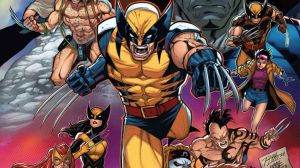Despite all the good he’s done, the lives he’s saved, and the disasters he’s helped prevent, Wolverine remains a villain in a hero’s clothing. His dark side is the rule, and his moments of goodness are the exception. While not everyone agrees with this assessment, the recent Age of Revelation announcements at San Diego Comic-Con 2025 strongly suggest that Marvel’s mutant universe brain trust does. They seem to believe Wolverine’s darkness is real—and that it’s finally time to remove the guardrails and let him fully embrace his true nature. Naturally, this doesn’t bode well for anyone who stands in his way. But for many fans, this version of Wolverine has been a long time coming.
Videos by ComicBook.com
As revealed in a recent article on the official Marvel website, the upcoming “Age of Revelation” X-Men event will feature a Sinister Six series. This event portrays a world set a decade in the future of the current Marvel continuity. Unlike the original Sinister Six, who were Spider-Man’s adversaries, this new iteration is organized by Mister Sinister and comprises Havok, Black Cat, Domino, Omega Red, Fantomex, and Venom. It appears their goal is to seize a portion of Revelation’s power, but they’ll need to overcome Wolverine to do so. However, the article describes Wolverine not as the hero he once was, but as an “Angel of Death” working to uphold Revelation’s tyrannical grip on the land.
Wolverine Becomes the “Angel of Death”

Assuming — based on the dystopian trajectory suggested by Age of Revelation — that being labeled an “Angel of Death” marks a villainous turn, then the idea of Wolverine embracing villainy becomes a compelling narrative twist. First, it’s clear such a shift wouldn’t have come easily. As shown in X-Men: Age of Revelation #0 by Joel MacKay and Edgar Delgado, and X-Men (2024) #19 by Joel MacKay and Sean Parsons, Wolverine is firmly aligned with Cyclops and others in opposition to Revelation during the lead-up to the event and shortly after its emergence. So, something significant must have happened in the years following to push Logan into supporting Revelation.
Second, there’s also the fact that while the Sinister Six are described as wanting to take some of Revelation’s power, that doesn’t exactly mean they’re doing it in the public’s interest. It’s more likely they’re doing it for Sinister’s and their own shady interests. In such a case, being an “Angel of Death” might be the best thing possible in an otherwise vile and corrupt situation.
A Dark Wolverine Might be the Ultimate Villain

Nevertheless, Wolverine embodies a villain’s temperament. He is easily provoked, and once triggered, he readily descends into violence. Unpredictable and consistently defiant of laws, rules, and regulations, he harbors deep emotional issues that he refuses to address, which only intensify his rage. Morally ambiguous, he will kill without hesitation and show no remorse for his savagery. Fortunately, within the Marvel Comics universe, he has managed to channel these destructive tendencies to fight for truth and justice, though he remains a fundamentally dangerous character.
If becoming the “Angel of Death” means Marvel is finally greenlighting a deeper and more sustained exploration of Wolverine’s darker side, most fans will be all for it. After all, heroes rarely get the chance to confront their demons, and when they do, it often leads to an iconic story for the ages. There’s no reason to believe the same won’t happen with a character as popular as Wolverine, whose history in the shadows, back alleys, and hole-in-the-wall pubs suggests there’s a wealth of content ready to be adapted.
Making Wolverine Bad will be Good for Others

But it’s not just the narrative potential of a Wolverine gone bad that a turn to the dark side offers; there is also a significant storytelling opportunity for other characters who must now deal with and worry about a “bent” Wolverine. For instance, what better development could there be for the Cyclops-Wolverine relationship than Cyclops leading one group of rebels against Revelations’ rule, while Wolverine works as Revelations’ henchman? Indeed, exploring the motivations and actions of an evil Wolverine keeps the character fresh and unpredictable.
Perhaps most fittingly for the series’ tone, portraying Wolverine as a villain perfectly captures the atmosphere of a dystopian world ruled by a mutant with godlike powers. It highlights the darkness and high stakes of a future where mutants and humans are at war, and mutants themselves are locked in a civil conflict. It reflects just how far things have fallen and how deeply Revelation’s influence has spread. It’s a powerful way to emphasize the weight of the Age of Revelation timeline. In fact, letting Wolverine be as bad as he wants to be may only mean good things for fans.









